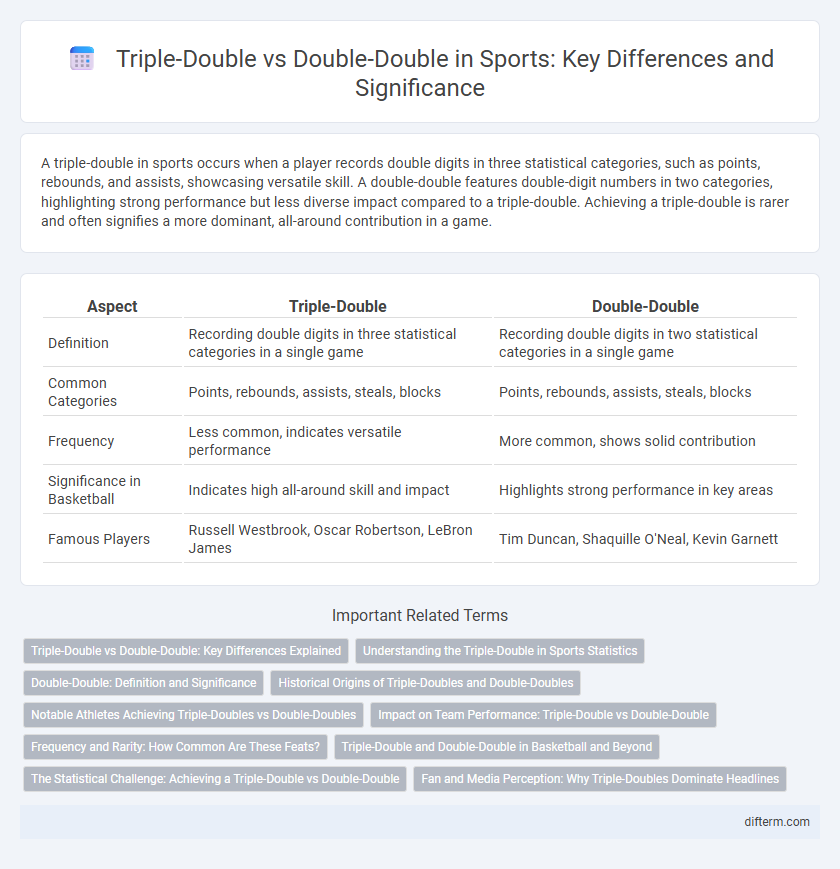A triple-double in sports occurs when a player records double digits in three statistical categories, such as points, rebounds, and assists, showcasing versatile skill. A double-double features double-digit numbers in two categories, highlighting strong performance but less diverse impact compared to a triple-double. Achieving a triple-double is rarer and often signifies a more dominant, all-around contribution in a game.
Table of Comparison
| Aspect | Triple-Double | Double-Double |
|---|---|---|
| Definition | Recording double digits in three statistical categories in a single game | Recording double digits in two statistical categories in a single game |
| Common Categories | Points, rebounds, assists, steals, blocks | Points, rebounds, assists, steals, blocks |
| Frequency | Less common, indicates versatile performance | More common, shows solid contribution |
| Significance in Basketball | Indicates high all-around skill and impact | Highlights strong performance in key areas |
| Famous Players | Russell Westbrook, Oscar Robertson, LeBron James | Tim Duncan, Shaquille O'Neal, Kevin Garnett |
Triple-Double vs Double-Double: Key Differences Explained
A triple-double in basketball occurs when a player achieves double digits in three statistical categories, typically points, rebounds, and assists, while a double-double requires double digits in only two categories. Triple-doubles demonstrate a player's versatility and impact across multiple facets of the game, often highlighting all-around skill and stamina. The statistical rarity and strategic value of triple-doubles generally position them as a higher benchmark than double-doubles in evaluating player performance.
Understanding the Triple-Double in Sports Statistics
A triple-double in sports statistics signifies a player achieving double digits in three key statistical categories, such as points, rebounds, and assists, during a single game, demonstrating all-around performance and versatility. In contrast, a double-double involves reaching double digits in two categories, indicating strong contribution but less comprehensive impact. Understanding these metrics aids in evaluating a player's overall influence and effectiveness on the court.
Double-Double: Definition and Significance
A double-double in basketball occurs when a player accumulates double-digit numbers in two statistical categories, typically points and rebounds or assists, within a single game. This achievement demonstrates a player's versatility and consistent contribution on both offense and defense, often impacting the game's outcome significantly. Recognized by the NBA and other leagues, double-doubles serve as a key metric for evaluating all-around player performance.
Historical Origins of Triple-Doubles and Double-Doubles
The historical origins of triple-doubles trace back to the early days of professional basketball, with Oscar Robertson being the first player to consistently achieve this feat during the 1961-62 NBA season. Double-doubles have a longer recorded history, recognized as a milestone highlighting balanced performance in two statistical categories like points and rebounds since the 1950s. These metrics have evolved to signify versatile player contributions, with triple-doubles gaining prominence as a hallmark of all-around excellence.
Notable Athletes Achieving Triple-Doubles vs Double-Doubles
Notable athletes achieving triple-doubles include NBA legends like Russell Westbrook, Oscar Robertson, and Magic Johnson, who exemplify versatility by recording double-digit points, rebounds, and assists in a single game. In contrast, double-double achievers such as Shaquille O'Neal and Dennis Rodman typically excel in two statistical categories, often points and rebounds, demonstrating dominance in specific aspects. The frequency of triple-doubles highlights an athlete's all-around impact, while double-doubles emphasize consistent excellence in key performance areas.
Impact on Team Performance: Triple-Double vs Double-Double
A triple-double, characterized by achieving double digits in three statistical categories, significantly enhances team versatility and offensive-rebounding efficiency, leading to increased scoring opportunities and defensive stops. Double-doubles, typically involving points and rebounds or assists, provide stability and consistency but lack the multifaceted impact on gameplay seen with triple-doubles. Teams with players consistently recording triple-doubles often experience improved win rates due to balanced contributions across scoring, playmaking, and defense.
Frequency and Rarity: How Common Are These Feats?
Triple-doubles occur far less frequently than double-doubles, highlighting their rarity and greater difficulty in basketball. While double-doubles are regularly achieved by many players each season due to the common accumulation of points, rebounds, or assists, triple-doubles require a more versatile and impactful performance across three statistical categories. The rarity of triple-doubles makes them a notable indicator of all-around player excellence and versatility on the court.
Triple-Double and Double-Double in Basketball and Beyond
A triple-double in basketball occurs when a player records double digits in three statistical categories, typically points, rebounds, and assists, showcasing exceptional versatility and all-around performance. A double-double, involving at least ten in two categories, highlights consistent dominance, often in scoring and rebounding. Beyond basketball, these terms describe standout achievements in various sports, emphasizing well-rounded skill sets and multi-dimensional impact.
The Statistical Challenge: Achieving a Triple-Double vs Double-Double
Achieving a triple-double in basketball demands a player to record double digits in three statistical categories, often points, rebounds, and assists, showcasing versatility and elite skill across multiple facets of the game. In contrast, a double-double requires double digits in only two categories, making it more common but still a significant indicator of a player's impact. The statistical challenge of reaching a triple-double highlights a player's ability to influence the game more comprehensively, reflecting a higher level of performance and endurance.
Fan and Media Perception: Why Triple-Doubles Dominate Headlines
Triple-doubles garner more fan admiration and media attention due to their rarity and demonstration of versatile skill across points, rebounds, and assists, signaling a player's all-around impact. Double-doubles, while impressive, focus on two statistical categories and often receive less emphasis because they are more common and perceived as less comprehensive. Media coverage tends to highlight triple-doubles as a benchmark for elite performance, fueling fan excitement and increasing player marketability.
triple-double vs double-double Infographic

 difterm.com
difterm.com